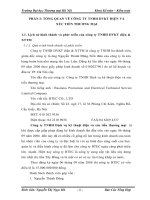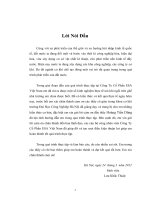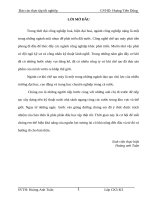Báo cáo thực tập israel Effect Comparison between different soil treatment methods for tomato at Yoav Katsir’s farm
Bạn đang xem bản rút gọn của tài liệu. Xem và tải ngay bản đầy đủ của tài liệu tại đây (4.91 MB, 35 trang )
Effect Comparison between different soil treatment methods for tomato at
Yoav Katsir’s farm
Student:
Nguyễn Thành Luân
Huỳnh Quốc Phát
Hồ Đức Việt
Phạm Việt Kim
Farm: Yoav Katsir
Advisor: Avner Levy, Ph.D
Ramat negev international training for advanced agriculture
Class of 2016-2017
02/04/2017
1
CONTENT
1. Abstract
2. Introduction
3. Material and method
4. Results
5. Discussion
6. Acknowledgment
2
How did we do that?
To determine which method is appropriate, we conducted two methods in two
different net house, after that we followed the tomato growth, weed situation, plant
pathogens and Compare the yields obtained between two net houses from which the
conclusions are derived.
3
After
the implementation period, observed and rely on the data obtained. We conducted the
analysis and evaluation of the two soil treatments that resulted is soil treatment using nylon
overlay is better.
Although the soil treatment method using nylon cover provides greater efficiency, there are also
certain constraints such as higher costs, more time spent on soil treatment that cause crop delay,
For workers also higher ... so, depending on the purpose and ability of the farmers that choose the
method accordingly.
4
2. Introduction
The geography of Israel is not naturally conducive to Agriculture.
Only 20% of the land area is naturally arable [2].
More than half of the land area is desert, and the climate and lack of water resources do not
favor farming.
The soil conditions here are mostly sandy soil.
5
Conditions in the Ramat Negev climate
Sandy soil
Extreme temp, between day and night, between
High radiation
High evapotranspiration
Water salinity
Low humidity
Poor nutrients
winter and summer
What is solution?
6
Control elements inside
Prevent disease and pest
greenhouse
Avoid the impact of weather
Increase water and fetilizer use
efficiency
7
5 basis factors in good agricultural production
human
-
Provide nutrients and
minerals
water
variety
Cultivating medium of
plants, the habitat of
many species of
beneficial
microorganisms
- Habitat and farming of
human
fertilizer
soil
Why soil treatment is extreme important?
8
Importance of
soil treatment before planting[1]
Convenient and easier
for planting and caring
tomato
Create better living
Increase porous
soil, improve some
soil properties
conditions for many
Increase in soil
types of soil
aeration
Destroy and
prevent some
pathogens of plants
microbiology
SOIL TREATMENT TECHNOLOGY
BEFORE PLANTING IS VERY NECESSARY
9
To show the importance of soil treatment before planting of tomato at
Yoav Katsir’s farm, we progressed the effect comparison between two
below
soil
treatment
methods:
One method is soil treatment with plastic cover, expose soil under sunlight, incubating
soil with plastic
Other method is soil treatment don’t use plastic cover, don’t expose also incubating
10
3. Materials and methods
3.1 materials
Nylon cover
Green house
Sandy soil
Water
Nylon
Fertilizers
Drip lines
Tractor
Non-Nylon cover
11
3.2 method
We combined 4 methods to show the difference between 2 soil treatment techniques:
Conducted soil treated with 2 technical reality.
Observing the growth of tomatoes, weeds and diseases.
Data collection
Analytical method
12
Conducted soil treated with non-nylon cover
Stage 1: killing and
cleaning farm
Picking up plants
Stage 2: treatment
Make flat land and
before planting
create seedbed
Remove driplines
Installing driplines
Take out all of plants
Expose soil under
and fruits
sunlight
Treated soil with
Growing new plants
chlorine solution
13
Conducted soil treated with nylon cover
Stage 1: killing and
cleaning farm
Picking up plants
Remove driplines
Take out all of plants
Expose soil under
and fruits
sunlight
Growing new plants
Stage 2: treatment
Tillage soil and create
before planting
seedbed
Installing driplines
Treated soil with
chlorine solution
Incubating soil with
Slitting plastic to
plastic
make bed
14
Stage 1: killing and cleaning farm (4-5 days)
Method:
Use cutter to cut plants
Take out plants and fruits by tractor
Remove driplines by worker
Purpose:
Removes the remnants of last season to return to the original ground
Disrupt the habitat of many species of microorganism, pests
Eliminating the remaining germs of the previous season.
Is the first step in the process of land, has an important role to facilitate the next step
15
Stage 2: treatment before planting
Tillage the soil (1-2 days)
Method: till the soil by tractor and at this step we can mix the soil with
greenery or compost to increase the amount of organic matter in the soil
Purpose:
Green material to mix with the soil
Breaking ground texture, making porous soil, providing good air circulation
Disrupt the habitat of many species of micro organism, pests not only at the
surface but also at the bottom of topsoil
Creating favorable conditions for the next step
Soil after tillage and mixing
16
Making bed (1-2 days) and installing driplines (12 days)
Installing driplines
Method: by handing and worker
Purpose:
Making convenient care
Create farm aesthetic
Creating favorable conditions for growing, caring and harvesting the fruit
Help operate the irrigation system to provide water and nutrients to plants
17
Incubate soil with plastic (15-20 days)
Method: use black plastic or white plastic to cover soil in 15 to 20 days
Purpose:
Helps retain moisture in soil
Kill some microorganisms that cause diseases of seedlings (plastic increase heat
of soil)
Soil after cover with white plastic
Limiting the loss of fertilizer and organic matter by some insects and rain
Helping soil and organic matter continue decomposition
18
Slitting plastic (1 days)
Method: Using a sharp knife to slit plastic after about 15-20 days of incubation
Purpose:
reduce heat soil to make possible preparation for planting
Air can circulate in the soil to help the beneficial microorganisms may operate in the best conditions , helpful for the development of
seedlings later
Before slitting
After slitting
19
Treated soil with chlorine solution (2-4 days)
Method: The chlorine powder is mixed with water in a certain proportion, then
use cup to watered in the soil where the new tomato is ready to grow in a
certain amount.
New tomatoes will be hand-grown
Purpose:
Clean the soil and remove any germs left in the soil
Help the seedlings grow healthy
This is final step of soil treatment before plant new seedling.
20
Observing method
Observation is way of gathering data by watching behavior, events, or noting physical characteristics in their
natural setting [3].
In our report we looked at the development of tomatoes in two farms in order to find the difference between
the two farms in terms of growth rate, disease status, weeds as well as the loss of water and fertilizer.
This method takes a lot of time because it must monitor the development of the tomato from early planting to
harvest
21
Data collection method
Data collection is the process of gathering and measuring information on targeted variables in an established systematic
fashion, which then enables one to answer relevant questions and evaluate outcomes [4].
The goal for all data collection is to capture quality evidence that then translates to rich data analysis and allows the
building of a convincing and credible answer to questions that have been posed [4] .
In this report we collect data by recording the harvested yield, collecting observable data, photographing, asking the
farmer for the required data.
22
Data analysis method
Analysis of data, is a process of inspecting, cleansing, transforming, and modeling data with the goal of discovering
useful information, suggesting conclusions, and supporting decision-making [5].
In this report we have made calculations based on the data collected, then there are comparisons and evaluations to
make the final conclusions.
23
4. Results
The difference comparison table between 2 greenhouse
Nylon cover method
Non-nylon cover method
Cost
High
Low
Yield
High
Low
Have a lot of new weeds and tomato plants from
Diseases and weeds
Have not pathogen from previous season
Irrigation
less
more
Time
1 to 2 month
1 to 2 week
previous season
24
Cost
The soil treatment method with nylon cover need material is nylon, so the cost will be more than other method.
In greenhouse that was not incubated by nylon had a lot of weeds and new tomatoes from previous season, so we
need the cost for workers to take them out. We need 18 workers worked in 2 hours to take them out and 2 to 3
times per season.
The nylon cover method need about 40 workers per day for a farm, the other method only need 20 workers per
day, so the cost for workers will be less than nylon cover method.
25









